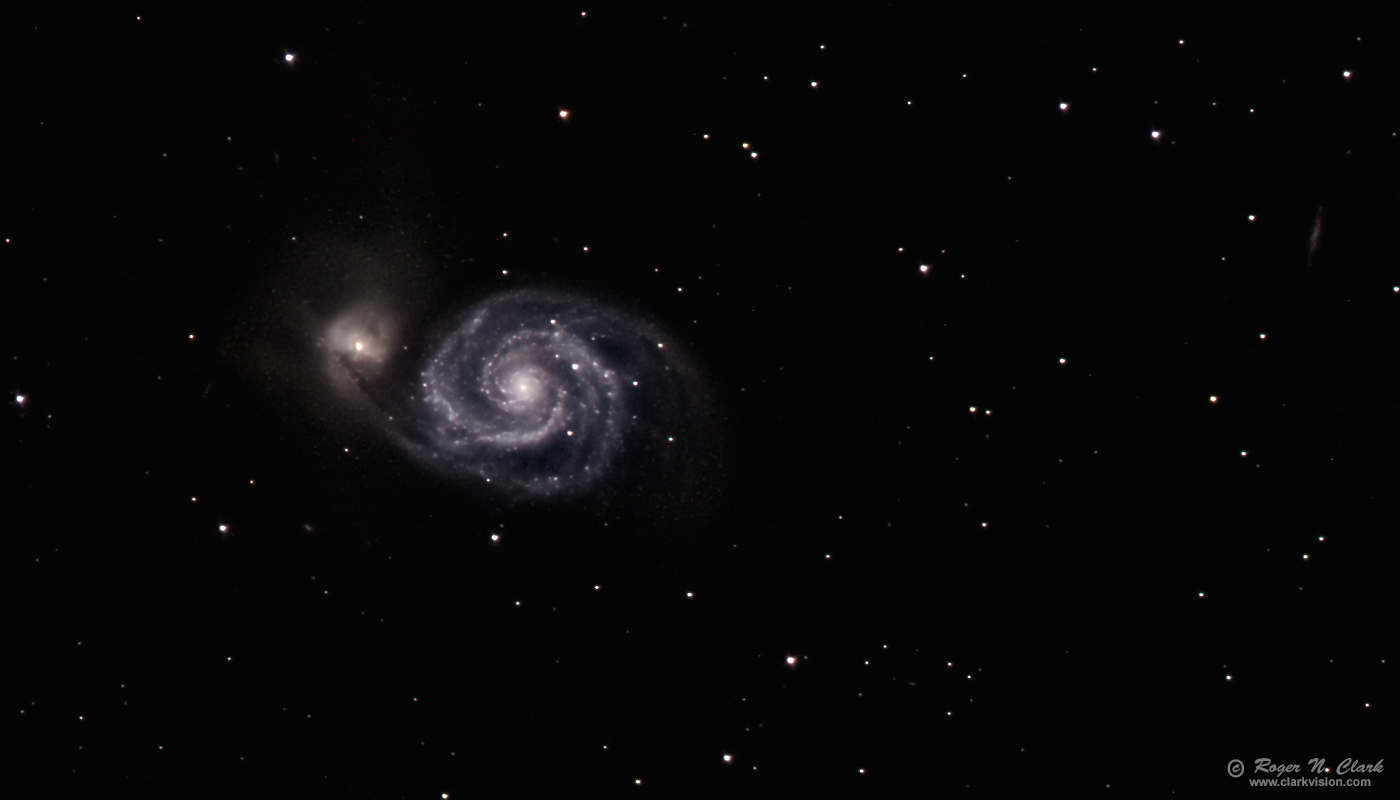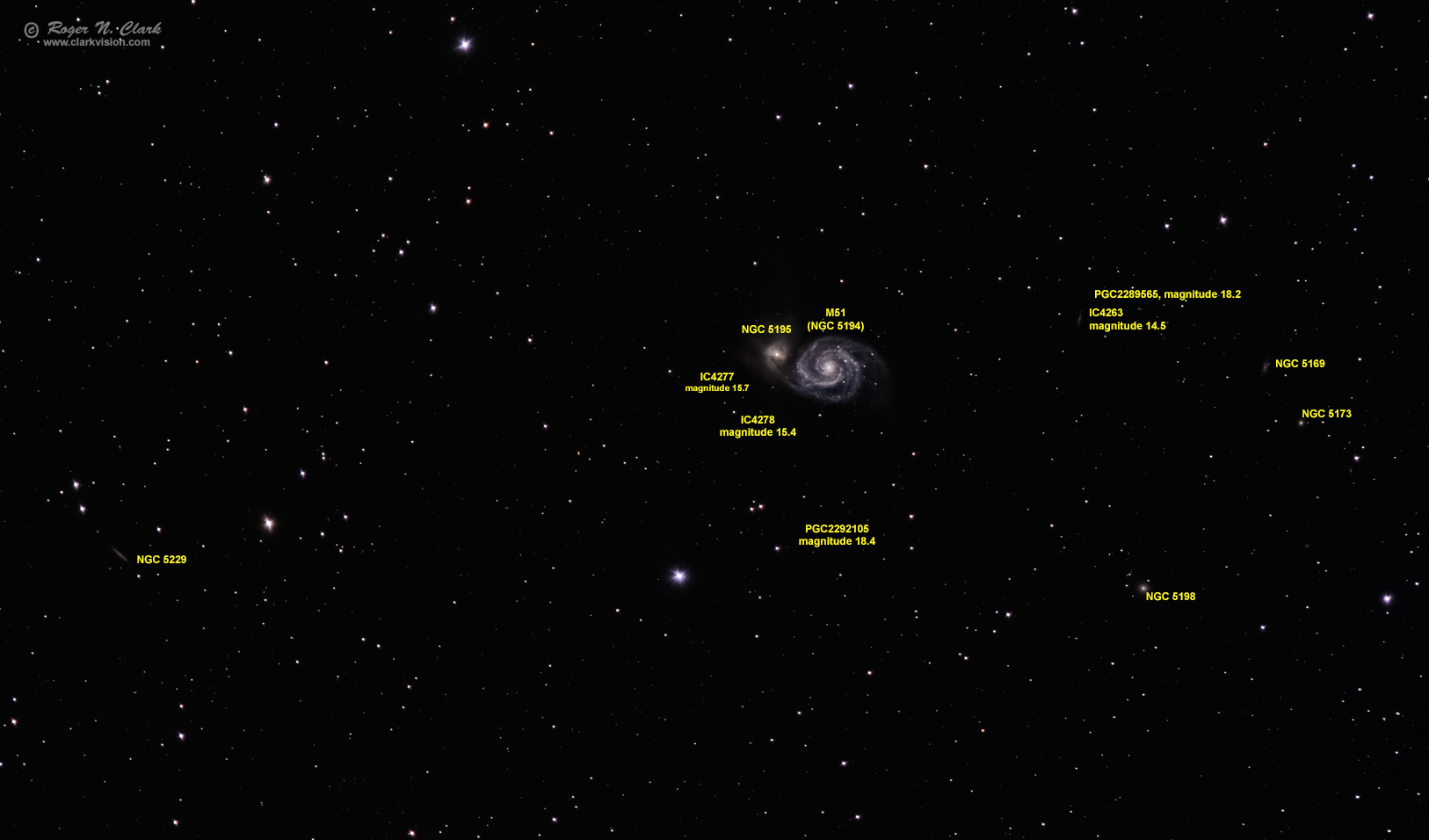| Home | Galleries | Articles | Reviews | Best Gear | New | About | Contact | Gallery Index | Previous |
Next |

| Home | Galleries | Articles | Reviews | Best Gear | New | About | Contact | Gallery Index | Previous |
Next |

The Whirlpool Galaxy is a beautiful spiral galaxy about a third the size of the full Moon. The spiral structure can be glimpsed in 6-inch telescopes in dark skies, and shows more and more detail with 8-inch and larger telescopes. This galaxy is on the cover of my book "Visual Astronomy of the Deep Sky" and detecting the spiral structure visually is the subject of Chapter 6. M51 is in the constellation Canes Venatici, near the end of the handle of the Big Dipper. Its distance is 15 to 35 million light years away. M51 was the first nebula found to have a spiral structure in 1845 by William Parsons, 3rd Earl of Rosse, using a 72-inch diameter telescope. It is amazing that a simple 4.2 inch diameter telephoto lens and digital camera can reveal the beautiful spiral structure with such detail. Other galaxies also show in the image, and are labeled below. Galaxies fainter than magnitude 18 are visible in the full resolution image. The small galaxy near the right edge is IC 4263.
Technical. This image was obtained with a Canon 7D Mark II 20-megapixel digital camera and 300 mm f/2.8 L IS II lens plus a 1.4x teleconverter giving 420 mm at f/4, ISO 3200 and 2-arc-seconds per pixel. Exposure time was 30 seconds per image with 106 frames obtained in a bright green zone on the light pollution scale. Total exposure time = 53 minutes. No dark frame subtraction, no flat fields. Tracking with an Astrotrac and no guiding. I elected shorter exposures because wind gusts were occasionally shaking the setup. The image here is sampled at 1.5 arc-seconds per pixel.
Post processing this small galaxy required different methodology than I have usually done. Stacking many images had to be very accurate or spatial resolution would be compromised. Accurate alignment is the Achilles Heel of multi-exposure astrophotography. I have found stacking software often is poor, destroying fine detail (look for a future article about this in my astrophotography series). To make this image I did the following. I first aligned the images with translate only using ImagesPlus. Then I aligned the resulting aligned images with autostar in ImagesPlus (which does translate, scale and rotate). That aligned the image to about a pixel. Then I fed that result into Deep Sky Stacker, turning off all calibration, and using 2x drizzle, which enlarged the images 2x. That aligned the images to 1/2 original pixel. The result was a well aligned stacked image with 1-arc-second per pixel sampling. The 53 minutes of exposure produced a high signal-to-noise ratio image, enabling Richardson-Lucy deconvolution to improve resolution. The deconvolved image was then adjusted for color using spectral classes of stars to guide color balance to make a natural color image.
The Exposure Factors, CEF, CEFA are measures of the relative amounts of light received from a subject. It can be used to fairly compare wildly different lens/telescope apertures and exposure times. For this image:

Modern DSLRs like the 7D Mark II include on sensor dark current suppression and low fixed pattern noise at ISOs around 1600 and higher, making no need for dark frame subtraction. Modern raw converters correct for light fall-off and also correct for hot/dead/stuck pixels. This makes processing low light images easy: simply align and average.
Here is an example single frame, full field from the 7D2 sensor, with light pollution (some subtracted in the raw converter): M51 single frame, full field of view, out of the raw converter, half resolution (475 megabytes). Note the excellent star images from corner to corner, and many small galaxies.
To learn how to obtain stunning images like this, please visit my Extensive Articles on Photography .
See my review of the Canon 7D Mark II and why it is so good for astrophotography: Canon 7D Mark II sensor analysis.
Keywords to this image = astrophoto-1 galaxy Messier night low-light digital_astro canon_7d2
Image ID: m51-420mm-rnclark_ipasa-ds2sdrizl-c03.10.2016.oJ6A8788-923.d-0.67x-c1s.jpg
| Home | Galleries | Articles | Reviews | Best Gear | Science | New | About | Contact |
Last updated December 20, 2025